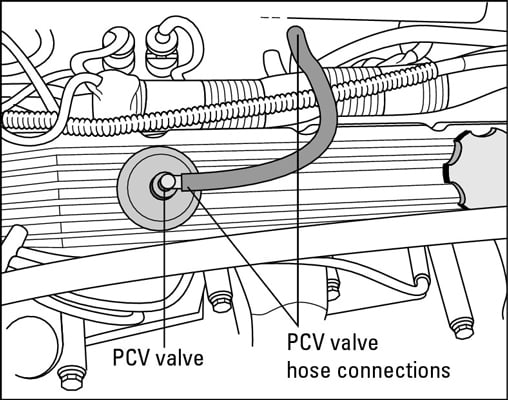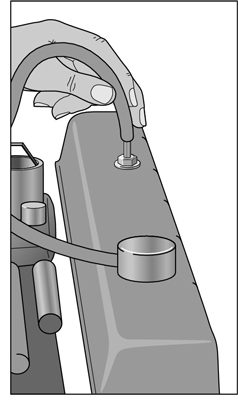Not every vehicle has a PCV (positive crankcase ventilation) valve. If yours has one, and your engine has been idling roughly or a malfunction indicator light goes on, check the PCV valve to make sure that it isn’t clogged with sludge from the contaminants in the exhaust fumes or stuck in the wide-open position.
The PCV valve is a vital part of the emissions control system on most vehicles. The PCV valve is usually plugged into a rubber grommet in the valve cover, as shown here:
 A PCV valve located in the valve cover
A PCV valve located in the valve cover A PVC valve located on the valve cover, with the hose that leads to it removed
A PVC valve located on the valve cover, with the hose that leads to it removedFollow these instructions to remove your vehicle’s PCV valve in order to check, clean, or replace it with a new one:
-
Locate the PCV valve and loosen the hose clamp if there is one, or pull the little L-shaped housing off the end of the valve.
-
Remove the valve.
Some PCV valves are held in place with a rubber grommet and can just be pulled free. Others are threaded into place. If you can’t unscrew the valve by hand, try to grasp its base with the open end of a combination wrench or a small crescent wrench.
-
Check the hose and the hose clamps or grommet.
Remove the hose and blow through it. If the hose is dry, brittle, soft, spongy, or full of sludge or hard deposits, you should replace it. If the clamps are rusty or the grommet looks deteriorated, you should replace them, too.
-
Screw in the new valve.
If the new valve screws into place, do this by hand to avoid stripping the threads in the valve cover. Make sure that the valve is seated securely (it should stick just a little when you try to unscrew it again), but don’t over-tighten it!
-
Reconnect the hose to the PCV valve.
Start the engine, and check around the PCV valve for leaks.

